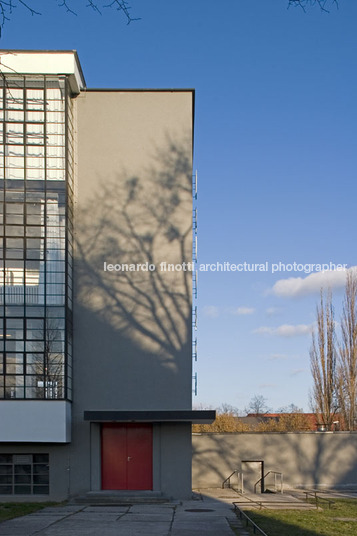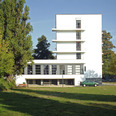bauhaus dessau, germany
- description
The Bauhaus Building by Walter Gropius
Built 1925–1926The Bauhaus originated in Weimar in 1919 as a new type of design school. In 1924, when further work in Weimar became impossible, the Bauhaus offered itself up to other towns. That Dessau, an aspiring industrial city in central Germany, was chosen by the Bauhaus Masters over Frankfurt am Main, for example, depended in part on the fact that it could offer the Bauhaus a new school building. Walter Gropius, founder of the Bauhaus in 1919 and its director until 1928, designed the building on behalf of the city of Dessau and in cooperation with Carl Fieger, Ernst Neufert and others in his private architectural practice – the Bauhaus did not have its own department of architecture until 1927. The Bauhaus workshops were integrated within the building’s interior design. The city of Dessau provided money for the new school building on a development site close to the train station and also for the Masters’ Houses, and remained the owner of both properties.
In his design, Walter Gropius refined architectonic ideas he first put into practice before WW I in the construction of the Fagus-Werke in Alfeld an der Leine. In Dessau as in Alfeld, the glass curtain wall suspended in front of the load-bearing framework defines the exterior of the workshop wing and openly shows the constructive elements. Gropius, rather than visually amplifying the corners of the cubic body of the building, allowed the glass surface to overlap the edges, thereby creating the impression of lightness.
Gropius consistently separated the parts of the Bauhaus building according to their functions and designed each differently. He thereby arranged the different wings asymmetrically – in relation to what is today the Bauhausstraße and the Gropiusallee respectively. In order to appreciate the overall design of the complex, the observer must therefore move around the whole building. There is no central viewpoint.
The glazed, three-storey workshop wing, the block for the vocational school (also three storeys high) with its unostentatious rows of windows, and the five-storey studio building with its conspicuous, projecting balconies are the main elements of the complex. A two-storey bridge which housed, e.g., the administration department and, until 1928, Gropius’s architectural practice, connects the workshop wing with the vocational school. A single-storey building with a hall, stage and refectory, the so-called Festive Area, connects the workshop wing to the studio building. The latter originally featured 28 studio flats for students and junior masters, each measuring 20 m². The ingenious design of the portals between the foyer and the hall and a folding partition between the stage and the refectory, along with the ceiling design and colour design, impart a grandiose spatial coalescence to the sequence of foyer-hall-stage-refectory, shaping the so-called Festive Area. The façade of the students’ dormitory is distinguished in the east by individual balconies and in the south by long balconies that continue around the corner of the building.
The entire complex is rendered and painted mainly in light tones, creating an attractive contrast to the window frames, which are dark. For the interior, the junior master of the mural workshop, Hinnerk Scheper, designed a detailed colour plan that, by differentiating between supporting and masking elements through the use of colour, aimed to accentuate the construction of the building.
Under pressure from the National Socialists, the “Hochschule für Gestaltung” (school of design) at the Bauhaus was closed in 1932. After suffering heavy bomb damage towards the end of the war, the building was provisionally repaired. Designated a protected monument in 1974, it was comprehensively restored for the first time in 1976. The Wissenschaftlich-kulturelle Zentrum Bauhaus Dessau (WKZ), which began to establish a Bauhaus collection and which organised events, introduced an institution that focused on the work of the Bauhaus Dessau into the building. The WKZ merged with two further education institutes in 1987 to form the Bauhaus Dessau, which in 1994 became the Bauhaus Dessau Foundation. With its declaration as a World Cultural Heritage Site in 1996, it was decided to carry out further extensive restoration, which was completed in 2006. Today, the Bauhaus is therefore once more a vital place for experimental design, research and teaching, similarly dedicated to the cultivation and communication of the Bauhaus legacy, and to work on contemporary urban issues.































